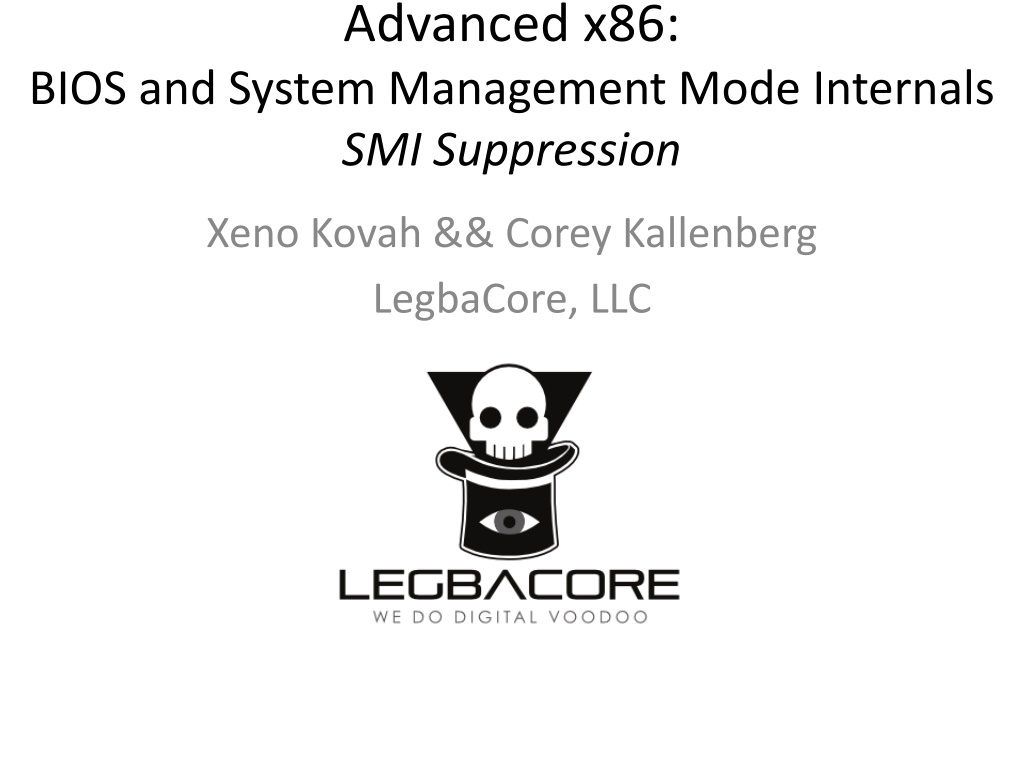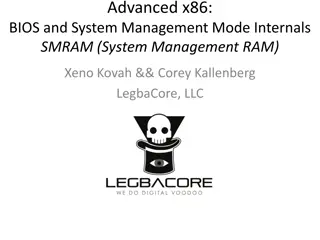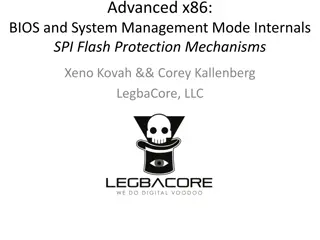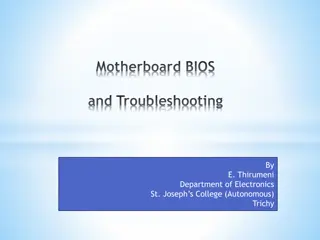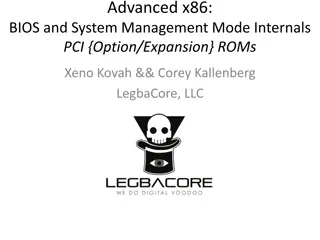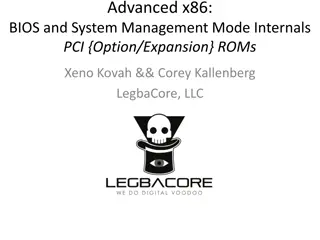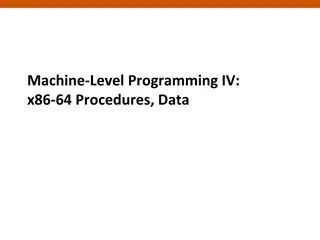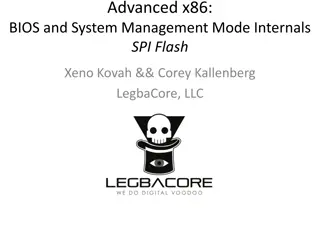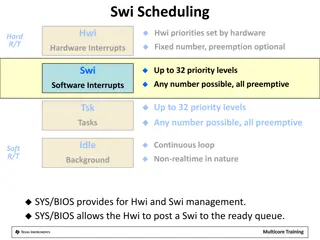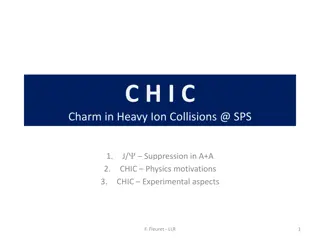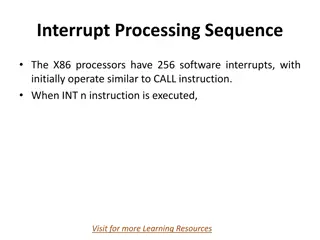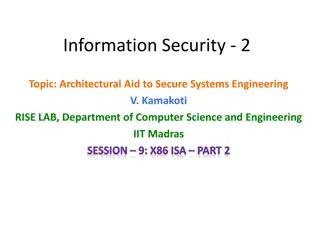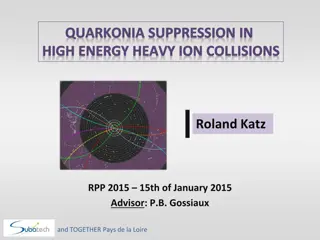Understanding SMI Suppression in x86 BIOS Management
Delve into the intricacies of SMI Suppression in x86 BIOS and System Management Mode internals, where SMI stands as a crucial defense mechanism to safeguard the BIOS flash from unauthorized modifications. Explore the impact of suppressing SMI generation and learn about the SMI_EN register's role in controlling and enabling specific instances of SMI signals. Uncover the nuances of disabling SMI generation on designated I/O ports and gain insight into the BIOS_CNTL register's significance in managing SMI suppression. This informative guide sheds light on the critical aspects of BIOS protection and system security in the x86 architecture.
Uploaded on Sep 25, 2024 | 1 Views
Download Presentation

Please find below an Image/Link to download the presentation.
The content on the website is provided AS IS for your information and personal use only. It may not be sold, licensed, or shared on other websites without obtaining consent from the author. Download presentation by click this link. If you encounter any issues during the download, it is possible that the publisher has removed the file from their server.
E N D
Presentation Transcript
Advanced x86: BIOS and System Management Mode Internals SMI Suppression Xeno Kovah && Corey Kallenberg LegbaCore, LLC
All materials are licensed under a Creative Commons Share Alike license. http://creativecommons.org/licenses/by-sa/3.0/ Attribution condition: You must indicate that derivative work "Is derived from John Butterworth & Xeno Kovah s Advanced Intel x86: BIOS and SMM class posted at http://opensecuritytraining.info/IntroBIOS.html 2
SMI Suppression SMM stands as the first line of defense for protecting the BIOS flash from being overwritten We ll cover how in the flash BIOS portion of the course What if the attacker simply suppressed SMI from being generated? They can, if the system isn t locked down properly: I/O Controller Hub Family 9 3
SMI_EN: SMI Control and Enable Register Located in the Power Management IO Registers (memory-mapped at PMBASE defined in LPC D31:F0) The SMI_EN register can enable or disable some very specific instances of SMI# or globally enable/disable all SMI# Shown above is the Global Enable/Disable for SMI# 4
SMI_EN We can disable the generation of SMI# on writes to IO port 0xB2 And a slough of others (BIOS_EN refers to BIOS being able to receive ACPI messages , it has nothing to do with enabling/disabling BIOS itself) 5
SMI_EN SMI_EN provides a lot of control over the generation of SMI# It can also enable/disable that periodic generation of SMI# You get the idea 6
Demo: SMI Suppression BIOS_CNTL register As we know, we (should be) unable to assert bit 0 in the BIOS_CNTL register located in LPC D31:F0, offset DCh Let s fix that! 7
Demo: SMI Suppression Locate the PMBASE address from LPC D31:F0, offset 40h This is mapped to the I/O address space, as indicated in the Base Address register description 8
Demo: SMI Suppression In this case we can see it is mapped to I/O starting at address 0x1000 Open up an I/O ports window and enter 0x1000 Be sure to check ACPI Power Management Base On some systems not doing this causes lockups or system crashes 9
Demo: SMI Suppression The bit to suppress global SMI# is at bit 0 in the SMI_EN register located at PMBASE + 30h It looks like uninitialized space, but everything is enabled Just not locked down 10
Demo: SMI Suppression Commence SMI# suppression! De-assert bit 0 so that SMI_EN is FFFF_FFFEh 11
Demo: SMI Suppression BIOS_CNTL register Now with SMI# suppressed we can enable writes to the BIOS flash by asserting bit 0 in the BIOS_CNTL register We ll cover this in more detail in the next section 12
Demo: SMI Suppression Notice that bit 0 remains asserted now whereas before disabling SMI# it would have been reset to 0 Now we can write to the BIOS. This is very bad. 13
Demo: SMI Suppression Running the write_bios_base_deadbeef.sys writes to the BIOS base to prove this point 14
Demo Video: Charizard Ring0 can modify authenticated EFI Variables, which allows trivial bypassing of Secure Boot We ll cover this in the UEFI secure boot portion of the class. For now just take my word for it: this is not good 15
SMI Suppression As we ll see in the next section, there is one secondary defense that could still work to prevent an attacker from being able to flash the BIOS under these circumstances However they can t be used to protect the UEFI variables because those must always be writeable Locking down the SMI_EN register is something that vendors don t really know about: 3216 of 8005 (~40%) systems measured did not have SMI_LOCK set The numbers are much higher if you rollback the BIOS to a vulnerable revision, which is typically permitted 16
SMI Suppression Prevention 1: GEN_PMCON1 GEN_PMCON1 is located in the LPC D31:F0 Power Management registers The vendor must (must must!) assert SMI_LOCK in the GEN_PMCON_1 register Don t give attackers the option of suppressing SMI# Especially since the system depends on SMM to protect the BIOS Flash!!! 17
SMI Suppression Prevention 2: BIOS_CNTL.SMM_BWP We ll cover this register during the BIOS flash portion of the course Raises the security level of the platform Suffice to say this is a very useful (newish) feature That isn t utilized very often 18
